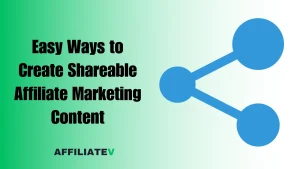Wondering can affiliate marketing make you rich in 2025? Get real numbers, smart strategies, and straight answers.

Can affiliate marketing make you rich?
Everyone’s asking: Can affiliate marketing really make you rich? It’s one of those questions that sounds simple but carries a lot of weight. People don’t want vague answers. They want something solid. They want to know if it’s possible to earn real money—enough to quit a job, pay off debt, or build a life on their own terms.
And they’re not asking out of curiosity. They’re asking because they’ve seen people post income screenshots and “proof” on social. They’re wondering if those numbers are real or just smoke and mirrors.
The search intent behind this question is clear. People want numbers. Not theories. Not pep talks. They want to know what it takes to hit $1,000 a month. $10,000. More. They want to see how many clicks, how many sales, what kind of content, and how long it takes. They want to know if it’s worth putting in the time. Or if it’s just another hype train.
That’s what this post is for.
We’ll break down what rich actually looks like in affiliate marketing, what kind of effort it takes to get there, the tools that help, the traffic you need, and the numbers that drive it all.
Key Takeaways
- Affiliate marketing can make you rich, but it takes time, skill, and a smart plan.
- Most people fail because they chase quick wins and promote weak offers.
- Real success comes from building trust, owning traffic, and scaling the right systems.
- Picking the right niche is more important than picking trending products.
- Building an email list is non-negotiable for long-term income.
- SEO and content still bring the best ROI in 2025.
- Consistency beats talent—showing up daily compounds results over time.
What “Rich” Even Means in Affiliate Marketing
Let’s get something straight—“rich” doesn’t mean the same thing for everyone.
For some, it means clearing six figures a year and never having to answer to a boss again. For others, it’s making $3,000 a month on autopilot while focusing on family or passion projects. Then there are the ones aiming for seven figures, building entire affiliate empires with teams, systems, and funnels running like clockwork.
But in affiliate marketing, rich isn’t just about income. It’s also about time freedom. No clock-ins. No meetings you didn’t ask for. No “can I take Friday off?” emails. That kind of freedom is worth more than most paychecks.
Now here’s the reality: not everyone hits six or seven figures. Most don’t. And that’s not because it’s impossible. It’s because they give up too early or never treat it like a real business. Some are okay with an extra $500 a month. Others want to retire on affiliate income.
Success looks different for each person. What matters is setting your number and building around that. Want five grand a month consistently? That’s doable. Want a million? Different strategy. More work. More patience. Bigger risks. Bigger rewards.
There’s no one-size-fits-all. But once you define what “rich” means to you, the rest becomes math and execution.
Can Affiliate Marketing Make You Rich in 2025?
Can affiliate marketing make you rich in 2025? The short answer: yes. But don’t expect it to happen overnight.
Affiliate marketing is like building a house. You need the right strategy, the right tools, and time to put it all together.
Let’s break it down into three parts:
1. Strategy: The Right Niche and Good Funnel
Success starts with choosing the right niche. Pick something you’re passionate about and where there’s demand. It can’t just be a random topic you think might work. A good niche connects your audience’s needs with products that solve their problems.
Once you’ve picked the niche, you need a strong funnel. A funnel takes people from interested strangers to buyers. It’s a series of steps—like landing pages, lead magnets, and email sequences—that guide them toward the final sale. Without a solid funnel, you’re losing potential customers every step of the way.
2. Traffic: Organic vs. Paid
You need traffic to make sales, and there are two main ways to get it: organic and paid.
Organic traffic is free but slow. You build it over time through things like SEO, social media, and content marketing. It’s the long game. You’ll put in a lot of work upfront without immediate results. But once that traffic starts rolling in, it keeps coming without constant effort.
Recommended Reading: Best SEO strategies for Affiliate Websites: How to Get Free Organic Traffic
Paid traffic is faster, but you need money to spend. Running ads on platforms like Google, Facebook, or Pinterest can bring in leads quickly, but if you’re not careful, it can burn a hole in your budget. It’s crucial to know how to convert those leads into sales before you scale.
3. Consistency: Years vs. Months
This isn’t a get-rich-quick game. If you’re expecting to make six figures in six months, you’re setting yourself up for disappointment. Real success takes time. Affiliate marketing is a long-term play. It’s about consistent effort—week after week, month after month.
Sure, you might hit some early wins. But the true payoff happens after you’ve consistently built and optimized your strategy, traffic, and funnel over the course of years, not months. Stay patient and keep improving. Success will come with time.
Recommended Reading: The Compounding Effect in Affiliate Marketing: Why Your First 6 Months Feel Slow (But Matter Most)
Affiliate marketing can make you rich, but it’s the combination of strategy, traffic, and consistency that turns those dreams into numbers you can count on.
The Real Math: Breaking Down the Numbers
Let’s look at the actual numbers. Because if we’re talking about getting rich, we need to talk income, expenses, and profit.
Here’s a simple example.
You’re promoting a product that pays $100 per sale. If you make 50 sales a month, that’s $5,000. Not bad. Now if you stack that across three or four solid offers, that monthly number can scale fast.
Now take a recurring model. Say you promote a tool or subscription service that pays $20 a month per customer. If you have 300 active signups, you’re at $6,000 per month—and that keeps coming in as long as people stay subscribed. That’s the kind of money that builds stability.
But it’s not all profit.
Let’s break down what you might spend each month:
- Email marketing tool: $50 to $100
- Funnel builder or website hosting: $30 to $100
- Paid ads (if you’re running them): $500 to $5,000
- Keyword tools or SEO software: $50 to $100
- Outsourced content or design: varies, but add a few hundred if you’re not doing it all yourself
So if you’re earning $6,000 but spending $1,500 on tools, content, and ads, your actual profit is around $4,500. That’s still strong—but it’s important to track everything.
Now, the gap between beginners and advanced affiliates is huge.
Beginners might struggle to make consistent sales. They’re still testing niches, learning how to write content that converts, and figuring out where to get traffic. Most of the time, they’re making less than $500 a month.
Advanced affiliates have systems. They know their audience. They’ve got funnels dialed in. Their content ranks, their email list converts, and their ad spend has a return.
These are the ones making $5,000, $10,000, even $50,000 per month. But they didn’t get there in 3 months. It took time, trial and error, and reinvesting profits back into the business.
Affiliate marketing scales. The more you dial in the math, the easier it is to grow without guessing.
Why Most Don’t Get Rich (And How to Avoid That)
Most people don’t get rich with affiliate marketing. Not because it doesn’t work—but because they treat it like a lottery ticket, not a business.
Here’s where most go wrong:
1. They chase trends. One week it’s crypto. Next week it’s AI tools. They jump into what’s hot without understanding the niche or the audience. No strategy. Just hype chasing. That rarely leads to steady income.
Read Also: Evergreen vs. Trending Content: What’s Best for Affiliate Marketing?
2. They promote junk. Low-quality products with high commissions look good on paper. But when people buy and get disappointed, they never trust you again. Short-term win, long-term loss.
Here’s How to Choose the Right Products to Promote as an Affiliate
3. They don’t build an email list. This one’s huge. If you send traffic straight to affiliate links without capturing emails, you lose control. You get one shot at a sale. That’s it. You’ll never build a real business that way.
Now, how do you avoid falling into that trap?
1. Build trust. Only promote stuff you’ve tested or would use yourself. Be honest about pros and cons. Help first. Sell second. That’s what builds long-term income.
2. Own your traffic. Platforms change. Algorithms shift. But your email list? That’s yours. Focus on growing it from day one. It gives you control, repeat sales, and a chance to build real relationships.
Learn How to Build a Strong Email List for Your Affiliate Marketing Business
3. Think long-term. This isn’t a quick flip. The money comes after the work. Stay consistent. Learn. Improve your funnel. Show up even when results are slow. That’s how you separate yourself from the 90 percent who quit too early.
Getting rich with affiliate marketing isn’t luck. It’s discipline. And it starts with doing the stuff most people skip.
Recommended Reading: 9 Common Affiliate Marketing Mistakes New Marketers Make and How to Avoid Them
3 Real Paths to Big Affiliate Income in 2025
There’s no one-size path to big income in affiliate marketing. But in 2025, three models still lead the pack. These aren’t side gigs. Each one can be a full-time business if you commit.
Let’s break them down:
1. SEO + Niche Blog
This model is all about writing helpful content that answers real questions people search for. You build a blog focused on a specific topic—like home office gear, travel credit cards, or fitness tools.
Then you write articles targeting keywords and link to affiliate products naturally inside those posts. You don’t need to be a writing genius, just helpful and consistent.
Once your content ranks on Google, the traffic and commissions start coming in—even while you sleep. But it takes months of steady publishing before you see strong results.
2. High-Ticket Funnels
Instead of chasing $20 commissions, this model focuses on products that pay out $500 or more per sale. You build a funnel—a landing page, email sequence, maybe even a webinar—that filters and warms up leads before pitching them. These are usually coaching programs, SaaS tools, or premium courses.
You can drive traffic through ads, organic content, or social media. If your funnel converts well, you don’t need many sales to make serious money. But building a good funnel takes work—and testing.
3. Authority YouTube Channel
Here, you build trust with your face and voice. You create videos around reviews, tutorials, comparisons, or topic deep-dives. People watch, click your links, and buy. Simple, but not always easy.
YouTube is fast for building credibility. People feel like they know you, and that speeds up the trust needed for affiliate sales. Plus, one solid video can bring in views (and commissions) for years.
Now here’s a quick breakdown of the pros and cons:
| Path | Pros | Cons |
|---|---|---|
| SEO + Niche Blog | Low cost to start Traffic is passive once it ranks Great long-term asset | Takes 3–6 months to see results Google updates can hurt traffic Writing and SEO can be a learning curve |
| High-Ticket Funnels | Big payouts with fewer sales Scales well with paid ads Funnels automate the process | Ads cost money and need testing Funnel setup can be complex Requires strong copy and sales skills |
| Authority YouTube | Builds trust fast Great for reviews and tutorials Can go viral and grow fast | On-camera work required Editing takes time or tools YouTube algorithm can be unpredictable |
All three work. But the key is focus. Pick one, stick with it, and go all in.
Conclusion
So, can affiliate marketing make you rich in 2025? Yes. But not by luck. And not by copying what everyone else is doing.
It takes a real plan. You need the right niche, a funnel that works, a way to get traffic, and the patience to keep going when the money’s not flowing yet.
Most people quit too soon. Or they treat it like a hustle, not a business. That’s why they never break through.
But if you focus, build trust, and show up every week—even when it’s quiet—you’ll get there.
Rich doesn’t happen overnight. But smart, consistent effort? That builds something real.
Frequently Asked Questions
Can affiliate marketing make you rich?
Yes, but it’s not magic. The ones who actually get rich from affiliate marketing treat it like a real business. They pick a niche they understand, create value-driven content, and build trust with their audience. Some build websites or blogs, others grow YouTube channels or email lists. The common thread? They stick with it. They test, fail, fix, and improve. It’s not about luck—it’s about systems and consistency. You’ll need to learn how to get traffic, convert visitors, and promote the right products. That takes time, especially if you’re starting from scratch. But once things click, the income becomes more stable and more scalable. Rich doesn’t mean “overnight success.” It means building something that works without you having to grind forever. If you’re serious, focused, and consistent, affiliate marketing can absolutely grow into something big—and yes, even make you rich over time.
How long does it take to make good money with affiliate marketing?
Most people don’t see solid income until they’ve put in at least 6 to 12 months of work. That’s assuming you’ve picked the right niche, stayed focused, and kept creating content that helps people. A lot of new affiliates post for a few weeks and expect $5,000 to show up. It doesn’t work that way. You’re building trust, traffic, and systems—and that takes time. You’ll also need to test different offers, build a basic email list, and figure out what gets clicks and sales. Some folks do start earning after just a few months, but they’re usually experienced or have a following already. Most beginners need at least a year to start making money that feels consistent. If you treat it like a real business, the long game pays off. Shortcuts don’t last.
Is affiliate marketing still worth it in 2025?
Absolutely. In fact, affiliate marketing is more stable in 2025 than it’s ever been. Brands are spending more on affiliates because it works. People trust creators and real reviews more than ads. And tools to get started are everywhere—email platforms, website builders, content tools—you name it. But here’s the deal: you can’t just throw up a few links and expect sales. The space is more competitive now. You need a clear focus, a niche that solves real problems, and content that actually helps. If you’re willing to invest time into learning and creating, it’s still one of the best low-cost ways to build income online. It gives you flexibility, ownership, and long-term potential. But only if you’re in it for the long haul. So yes, it’s 100% still worth it—just skip the shortcuts and treat it seriously.
What’s the easiest way to start affiliate marketing with no money?
Start by using free platforms. YouTube, TikTok, Medium, and Quora all let you post content without spending a dime. Choose a niche you understand, then help people with useful, clear content. For example, if you know about fitness, create short videos or blog posts about workouts or nutrition tips. Then recommend related products—like supplements, gear, or programs—using your affiliate links. You can also sign up for free email tools like Systeme or ConvertKit’s free plan and start building a list. That lets you stay in touch with people and keep promoting offers long-term. You won’t grow fast without money, but you can grow if you stay consistent. The trade-off is time. The upside is you’re building skills and systems that compound. So yes, you can start for free—but expect to trade your time until you’re ready to reinvest your earnings.
Why do most people fail at affiliate marketing?
They either quit too soon or jump in with the wrong expectations. A lot of people think affiliate marketing is fast money. So they grab random products, spam links, or copy what someone else is doing without understanding why it works. That’s a quick way to burn out—or worse, get banned. Others never build a list or control their traffic. They depend on platforms that can shut them down anytime. The real reason most fail? No patience and no plan. They don’t give it enough time to test and improve. But those who focus on one niche, stick to one strategy, and build trust? They win. The key is playing the long game. Create value, build your own audience, and treat it like a business. That’s how you avoid the traps most fall into—and actually make affiliate marketing work.






